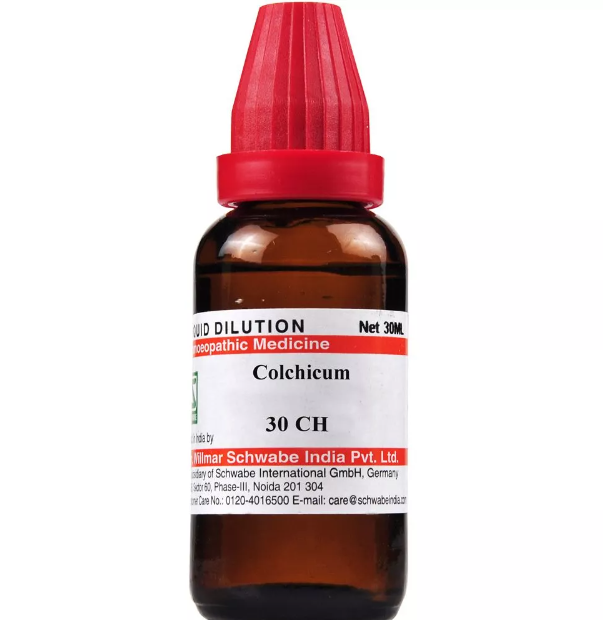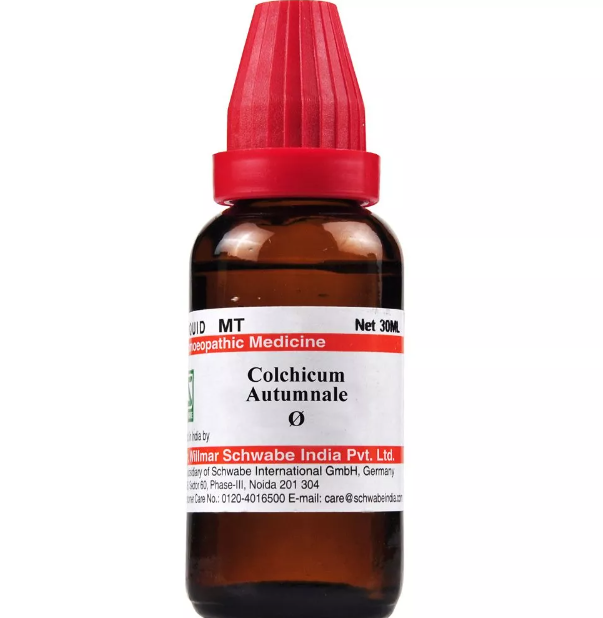COLCHICUM AUTUMNALE Q, 6C, 12C, 30C, 200C, 1M, 10M USES AND SYMPTOMS
 Colchicum Autumnale
Colchicum Autumnale
(Meadow Saffron)
Colch.
Primarily affects muscles, periosteum, and joint synovial membranes. Effective in relieving gouty attacks, especially in chronic conditions. Affected areas are red, hot, and swollen with tearing pain worse in the evening, at night, and when touched. Stubbing toes causes severe pain. Symptoms include extreme weakness, internal coldness, and a tendency to collapse, along with effects from lack of sleep and intense study. Electrical shock-like sensations in half of the body, adverse effects from suppressed sweat, and dreams of mice.
Head: Frontal, temporal, occipital headaches, and pain in the neck, worse in the afternoon and evening.
Eyes: Unequal pupils; left pupil contracted. Visual acuity varies (cataracts). Increased tearing in open air; severe tearing eye pain, dim vision after reading, and spots before the eyes.
Ears: Itching and sharp, shooting pains below the right tragus.
Face: Facial muscle pain, worse with movement. Tingling and swelling, cheeks are red, hot, and sweaty. Irritability due to pain. Pain behind the right lower jaw angle.
Stomach: Dry mouth, burning tongue, painful gums, and teeth. Thirst with stomach pain and flatulence. The smell of food, especially fish, causes nausea and fainting. Excessive salivation, vomiting of mucus, bile, and food, worse with motion; cold sensation in the stomach. Craving for various foods but aversion upon smelling them, leading to nausea. Gouty stomach pain, burning or icy coldness in the stomach and abdomen, thirst for effervescent and alcoholic drinks. Pain in the transverse colon.
Abdomen: Abdominal gas distension and inability to stretch legs. Rumbling sounds, liver region pain, distended caecum and ascending colon, fullness, and continuous rumbling. Ascites.
Stool: Painful, scanty, jelly-like mucus (intestinal catarrh); anal pain as if torn open (proctitis) with prolapse. Autumnal dysentery; stools contain white shreddy particles. Ineffectual pressing; feels stool in rectum but cannot expel.
Urinary: Dark, scanty or suppressed; bloody, brown, black, inky; contains decomposed blood clots, albumin (nephritis), and sugar (diabetes).
Female: Genital itching, cold sensation in thighs post-menses, sensation of swelling in vulva and clitoris.
Heart: Anxiety in heart region, weak impulse. Severe pain, oppression, and dyspnea with pericarditis, thread-like pulse. Weak heart sounds and low tension pulse.
Back: Aching in lumbar and lumbosacral region, dull loin pain, backache relieved by rest and pressure.
Extremities: Sharp pain down left arm, tearing in limbs in warm weather, stinging in cold. Pins and needles in hands and wrists, numb fingertips. Pain in front of thigh, abolished right plantar reflex, lame and weak limbs, tingling. Pain worse in evening and warm weather, stiff joints, shifting rheumatism, worse at night. Inflamed great toe, gout in heel, cannot bear touch or movement, tingling in fingernails. Knees knock together, difficulty walking. Edematous swelling and cold legs and feet.
Skin: Blotchy, papular rash on face, pink spots on back, chest, and abdomen. Urticaria.
Modalities: Worse from sunset to sunrise, motion, loss of sleep, smell of food, evening, and mental exertion. Better when stooping.
Relationship: Antidotes: Thuja, Camphor, Cocculus, Nux Vomica, Pulsatilla. Compare with Colchicinum, Carbo Vegetabilis, Arnica, Lilium Tigrinum, Arsenicum, Veratrum.

SYMPTOMS OF COLCHICUM AUTUMNALE
Head:
Frontal, temporal, occipital headaches, and neck pain, worse in the afternoon and evening.
Eyes:
Unequal pupils; left pupil contracted.
Varying visual acuity (cataracts).
Increased tearing in open air; severe tearing eye pain.
Dim vision after reading and spots before the eyes.
Ears:
Itching and sharp, shooting pains below the right tragus.
Face:
Facial muscle pain, worse with movement.
Tingling and swelling, red, hot, and sweaty cheeks.
Irritability due to pain.
Pain behind the right lower jaw angle.
Stomach:
Dry mouth, burning tongue, painful gums, and teeth.
Thirst with stomach pain and flatulence.
Nausea and fainting from the smell of food, especially fish.
Excessive salivation and vomiting of mucus, bile, and food, worse with motion.
Cold sensation in the stomach.
Craving for various foods but aversion upon smelling them, leading to nausea.
Gouty stomach pain, burning or icy coldness in the stomach and abdomen.
Thirst for effervescent and alcoholic drinks.
Pain in the transverse colon.
Abdomen:
Gas distension and inability to stretch legs.
Continuous rumbling and fullness.
Liver region pain, distended caecum and ascending colon.
Ascites.
Stool:
Painful, scanty, jelly-like mucus (intestinal catarrh).
Anal pain as if torn open (proctitis) with prolapse.
Autumnal dysentery; stools with white shreddy particles.
Ineffectual pressing; stool in rectum but cannot expel.
Urinary:
Dark, scanty, or suppressed urine; bloody, brown, black, or inky.
Urine contains decomposed blood clots, albumin (nephritis), and sugar (diabetes).
Female:
Genital itching.
Cold sensation in thighs post-menses.
Sensation of swelling in vulva and clitoris.
Heart:
Anxiety in heart region, weak impulse.
Severe pain, oppression, and dyspnea with pericarditis.
Thread-like pulse, weak heart sounds, and low tension pulse.
Back:
Aching in lumbar and lumbosacral region.
Dull loin pain, backache relieved by rest and pressure.
Extremities:
Sharp pain down left arm.
Tearing in limbs in warm weather, stinging in cold.
Pins and needles in hands and wrists, numb fingertips.
Pain in front of thigh, abolished right plantar reflex.
Lame and weak limbs, tingling.
Pain worse in evening and warm weather.
Stiff joints, shifting rheumatism, worse at night.
Inflamed great toe, gout in heel, cannot bear touch or movement.
Tingling in fingernails.
Knees knock together, difficulty walking.
Edematous swelling and cold legs and feet.
Skin:
Blotchy, papular rash on face.
Pink spots on back, chest, and abdomen.
Urticaria.
Modalities:
Worse from sunset to sunrise, motion, loss of sleep, smell of food, evening, and mental exertion.
Better when stooping.
selection of the potency
Individualization:
- Homeopathy is based on the principle of treating the individual, not just the disease. The unique symptoms and characteristics of the person are crucial in determining the most suitable potency.
Intensity of Symptoms:
- The intensity of the symptoms guides the choice of potency. If the symptoms are intense and acute, a lower potency (e.g., 6C, 30C) might be considered. For chronic conditions with less intensity, higher potencies (e.g., 200C, 1M) may be appropriate.
Sensitivity of the Patient:
- Some individuals are more sensitive to homeopathic remedies, while others may require higher potencies. The practitioner considers the patient’s sensitivity when selecting the potency.
Acute vs. Chronic Conditions:
- Lower potencies are often used for acute conditions, while higher potencies may be considered for chronic or long-standing issues.
Previous Response to Potencies:
- The patient’s response to previous homeopathic treatments helps guide the choice of potency. If a particular potency has been effective in the past, it may be repeated or adjusted as needed.
Vital Force and Susceptibility:
- Homeopathy views illness as a disturbance in the vital force. The practitioner assesses the patient’s overall vitality and susceptibility to determine the appropriate potency.
Aggravation or Amelioration:
- The direction of the symptom response (aggravation or amelioration) after taking a remedy can influence the choice of potency.
Miasmatic Considerations:
- In classical homeopathy, the concept of miasms (inherited disease tendencies) is considered. The practitioner take this into account when selecting the potency.
Practitioner Experience:
- The experience and preference of the homeopathic practitioner play a role. Some practitioners may have success with certain potencies based on their clinical experience.
SAFETY INFORMATION
- Do not exceed the recommended dose by physician
- Keep out of the reach of children
- Store in a cool dry place away from direct sunlight
- Maintain half an hour gap between food/drink/any other medicines and homoeopathic medicine
- Avoid any strong smell in the mouth while taking medicine e.g. camphor, garlic, onion, coffee, hing
Medicine images use for reference only selection of homeopathic medicine depends on the individual’s specific symptoms and overall constitution. Moreover, homeopathy is a holistic system of medicine that treats the individual as a whole. In addition to addressing the physical symptoms, it takes into account the emotional and mental state of the person. Consequently, it’s crucial to consult with a qualified homeopathic practitioner for personalized treatment.
The information provided on this website is intended solely for educational purposes. Always seek the advice of your physician or other qualified health provider.
